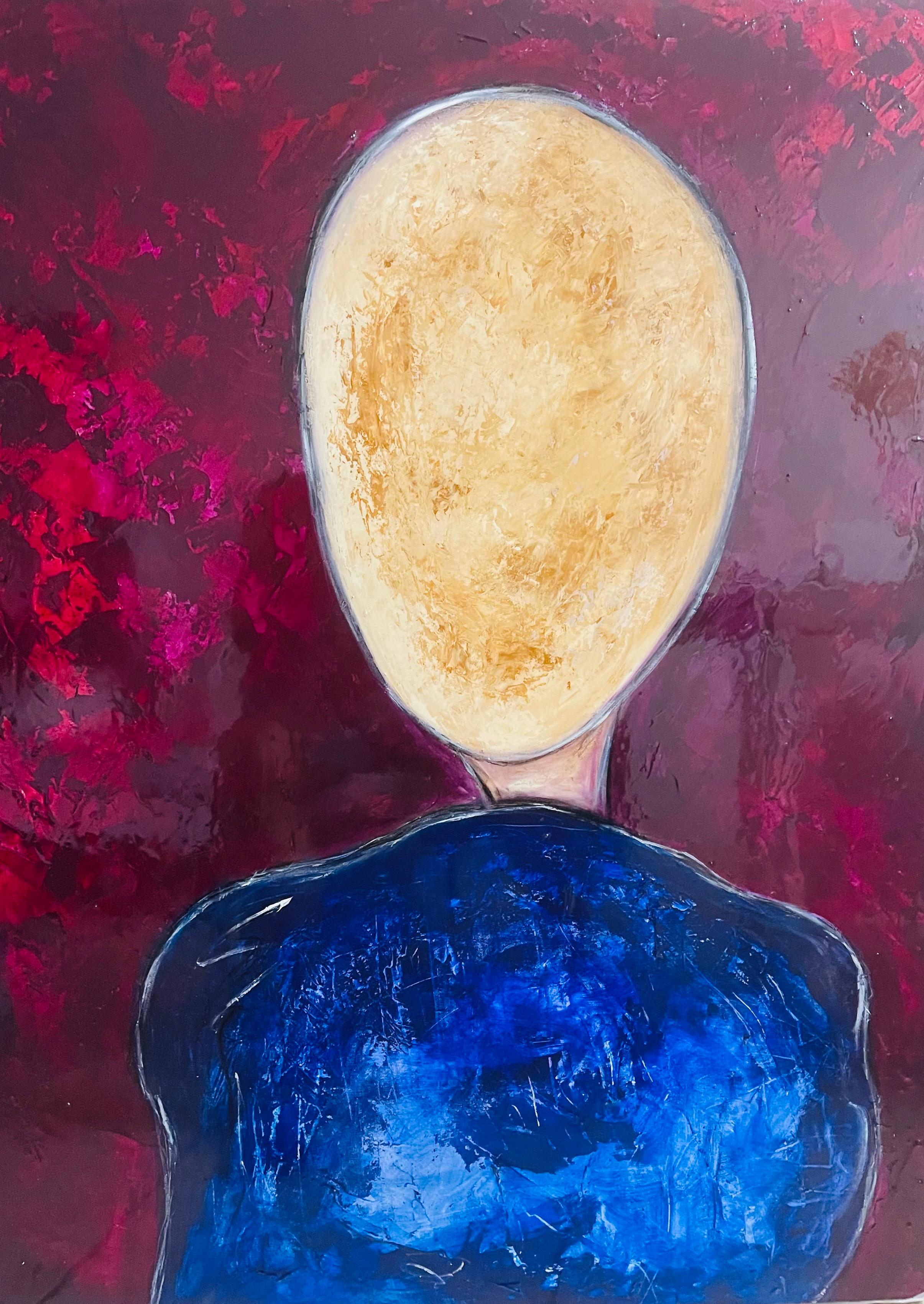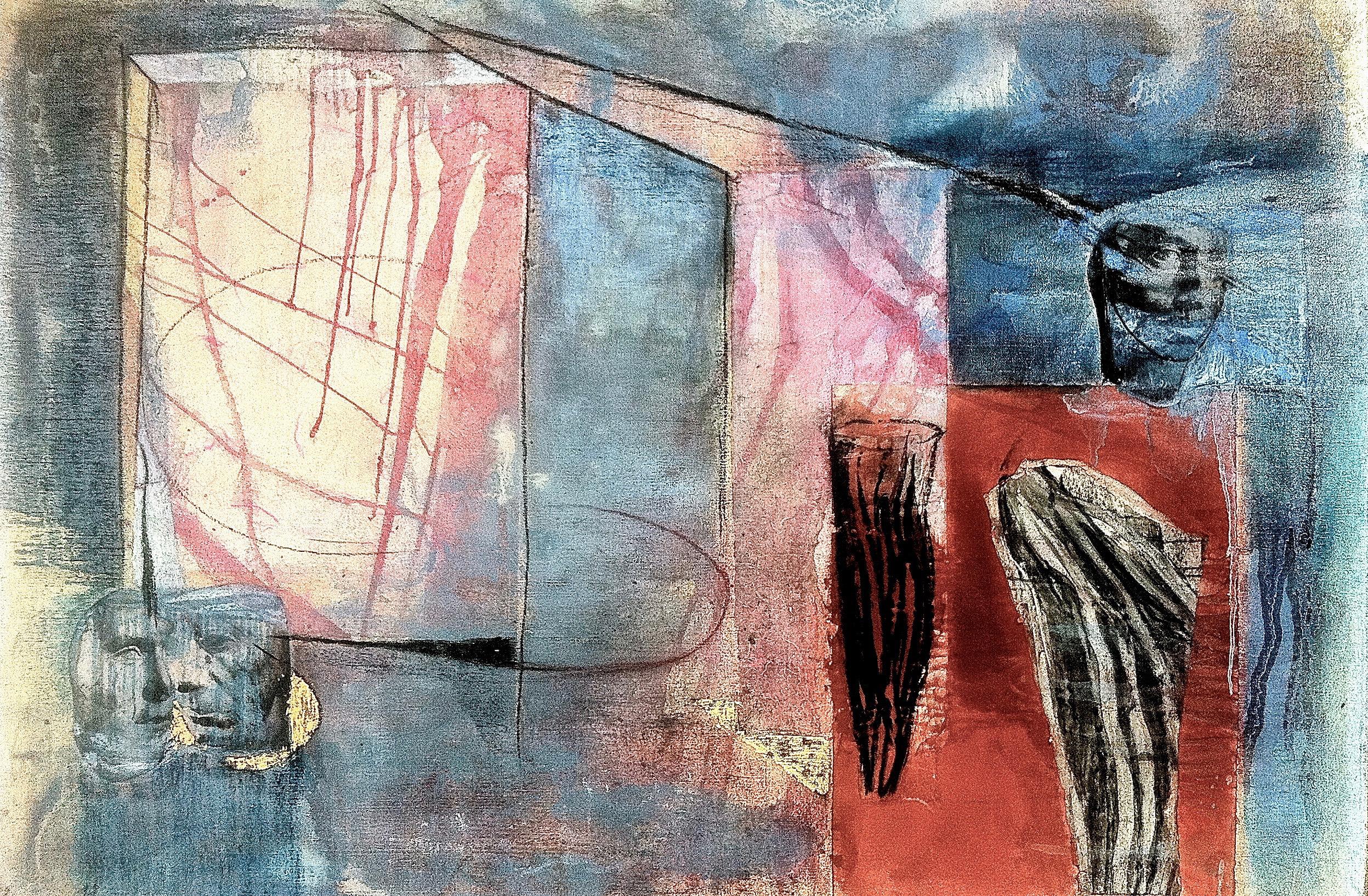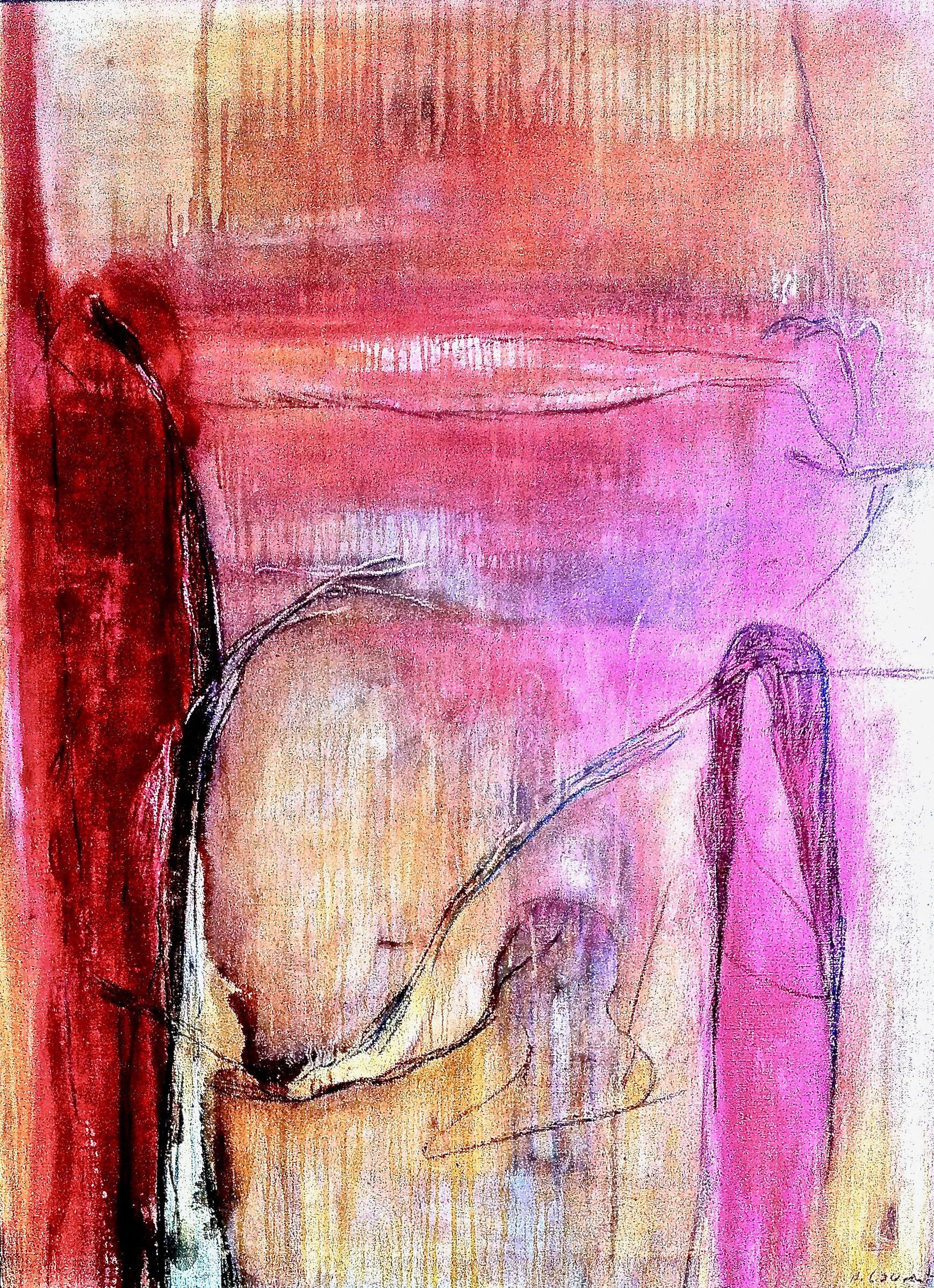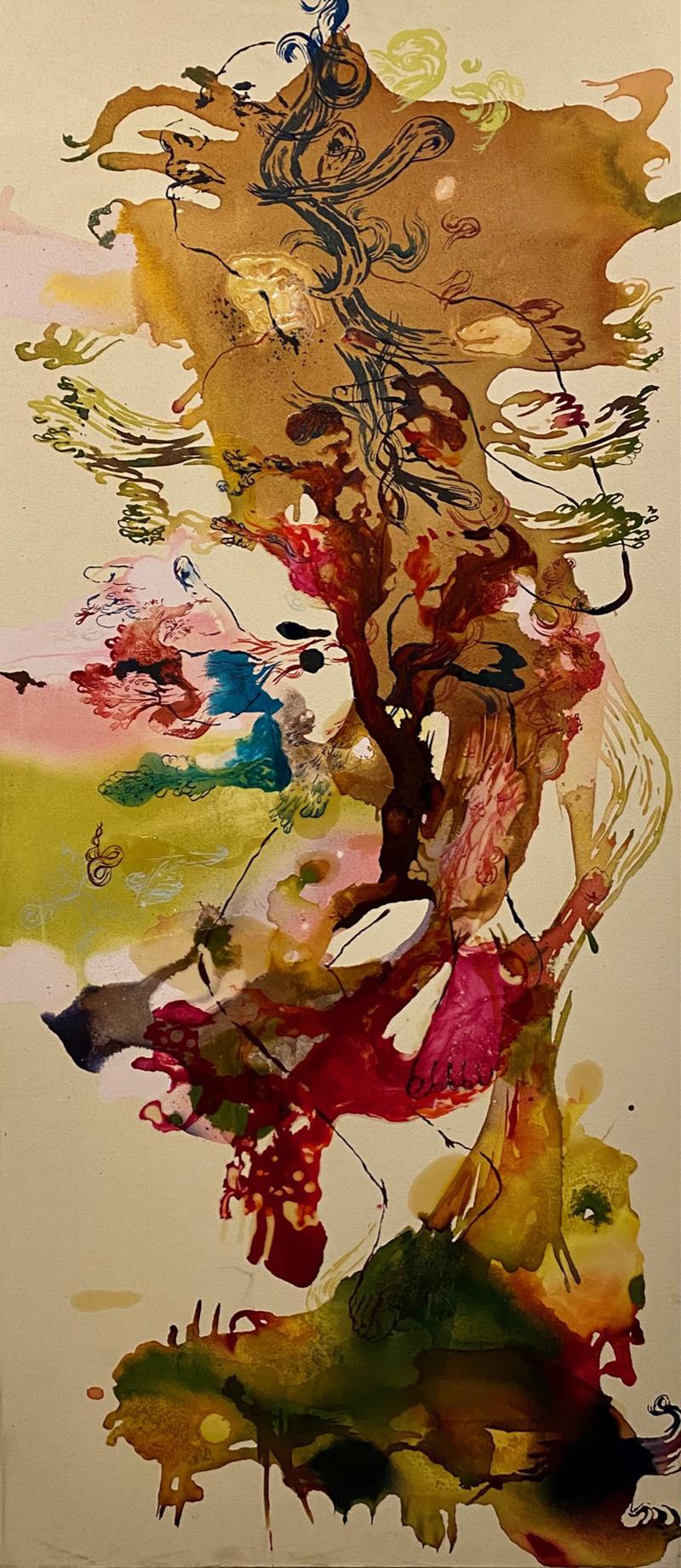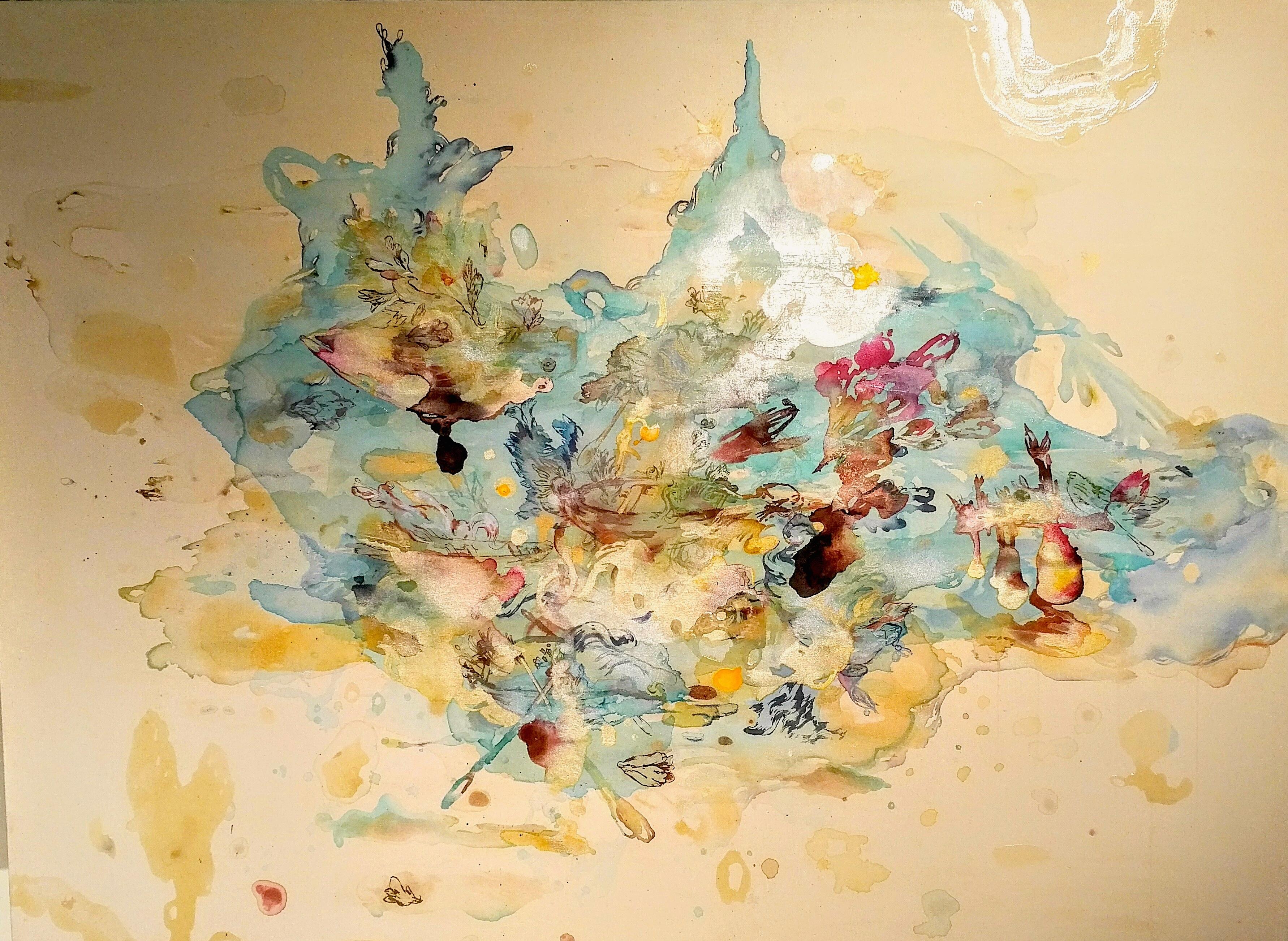Items Similar to Eccentric discharges of a turquoise-yellow core / - Energetic traces -
Want more images or videos?
Request additional images or videos from the seller
1 of 8
Eccentric discharges of a turquoise-yellow core / - Energetic traces -c. 1975
c. 1975
About the Item
Klaus Oldenburg (*1942 Berlin), Eccentric discharges of a turquoise-yellow core, around 1975. paint and cast resin on chipboard, 39 x 59 cm (inside dimension), 42 x 62 (frame), unsigned.
- isolated rubbed spots, otherwise in good condition
- Energetic traces -
About the artwork
Discharges emerge from a yellow energy core with a turquoise corona, reflected in black and red traces of colour. A snapshot that freezes the moment and at the same time is an ongoing processual movement. In this way, time itself is represented as a perpetual moment, which further enhances the dynamics of the image.
The synthetic resin used creates a glossy surface that literally seals the motif within itself. As a result, it does not appear to have been made by an artist's hand, but as something autonomous, fixed by a quasi-scientific process. The flow of the synthetic resin, which is reflected in the motif, also contributes to the effect of independence: The energetic discharges have found their adequate visible form in the flowing movements of the material. We seem to be witnessing an event in the atomic or subatomic world, which becomes present in the event of form and colour. Thus, the abstract art before our eyes is by no means purely abstract, but has a representational connotation and is a rare pictorial example of the Space Age.
About the artist
Born in Berlin, Klaus Oldenburg studied at the State School of Civil Engineering in Berlin from 1961 to 1964 and then worked as a civil engineer and architect until 1967. From 1967 to 1968 he ran the jazz club and artists' meeting place "Kilroy" in Berlin-Wilmersdorf, and then devoted himself entirely to art as a freelance painter. From 1968 to 1972 he had a studio in Berlin-Kreuzberg and from 1972 in Berlin-Friedenau. Since 1972, Oldenburg, who belonged to the Kreuzberg Bohemians, has shown his work at the Free Berlin Art Exhibition.
GERMAN VERSION
Klaus Oldenburg (*1942 Berlin), Exzentrische Entladungen eines türkis-gelben Kerns, um 1975. Farbe und Gießharz auf Spanplatte, 39 x 59 cm (Innenmaß), 42 x 62 (Rahmen), unsigniert.
- vereinzelte beriebene Stellen, sonst in gutem Zustand
- energetische Spuren -
zum Kunstwerk
Aus einem gelben Energiekern mit türkiser Corona emergieren Entladungen, die sich in schwarz-roten Farbspuren niederschlagen. Eine Momentaufnahme, die den Augenblick fixiert und zugleich ein fortwährender prozessualer Bewegungsablauf ist. Auf diese Weise wird die Zeit selbst als ein sich perpetuierender Augenblick zur Darstellung gebracht, was die Dynamik des Bildes zusätzlich steigert.
Das verwendete Kunstharz erzeugt eine glänzende Oberfläche, die das Motiv förmlich in sich selbst versiegelt. Dadurch wirkt es nicht wie von Künstlerhand verfertigt, sondern als etwas Autonomes, das durch ein gleichsam wissenschaftliches Verfahren fixiert worden wäre. Zur Eigenständigkeitswirkung trägt auch der sich in der Motivik niederschlagende Fluss des Kunstharzes bei: Die energetischen Entladungen haben in den Fließbewegungen des Materials ihre adäquate sichtbare Form gefunden. Wir scheinen einem Geschehen der atomaren oder subatomaren Welt beizuwohnen, das in dem Form- und Farbereignis präsent wird. Damit ist die vor Augen stehende abstrakte Kunst keineswegs rein abstrakt, sondern gegenständlich konnotiert und ein rares malerisches Beispiel für die Epoche des Space Age.
zum Künstler
In Berlin geboren, studierte Klaus Oldenburg von 1961-1964 an der Staatlichen Ingenieurschule für Bauwesen Berlin und war im Anschluss bis 1967 als Bauingenieur und Architekt tätig. Von 1967-1968 führte er den Jazzclub und Künstlertreff "Kilroy" in Berlin-Wilmersdorf, um sich dann als freischaffender als Maler ganz der Kunst zu widmen. Von 1968 bis 1972 hatte er ein Atelier in Berlin-Kreuzberg und ab 1972 in Berlin-Friedenau. Von 1972 an beschickte der zum Künstlerkreis der "Kreuzberger Boheme" zählende Oldenburg die Freie Berliner Kunstausstellung.
- Attributed to:Klaus Oldenburg (1942, German)
- Creation Year:c. 1975
- Dimensions:Height: 23.23 in (59 cm)Width: 15.36 in (39 cm)Depth: 0.79 in (2 cm)
- Medium:
- Period:
- Condition:
- Gallery Location:Berlin, DE
- Reference Number:1stDibs: LU2438212663472

About the Seller
5.0
Vetted Seller
These experienced sellers undergo a comprehensive evaluation by our team of in-house experts.
Established in 2014
1stDibs seller since 2023
7 sales on 1stDibs
Typical response time: 7 hours
- ShippingRetrieving quote...Ships From: Berlin, Germany
- Return PolicyA return for this item may be initiated within 14 days of delivery.
More From This SellerView All
- Eccentric discharges of a blue-red core / - Energetic traces -Located in Berlin, DEKlaus Oldenburg (*1942 Berlin), Eccentric discharges of a blue-red core, around 1975. paint and cast resin on chipboard, 39 x 59 cm (inside dimension), 42 x 62 (frame), signed on the...Category
1970s Abstract Abstract Paintings
MaterialsResin
- Mary Magdalene - Faith transforms inner into outer beauty and conquers death -By Balthasar DennerLocated in Berlin, DEBalthasar Denner (1685 Hamburg - 1749 Rostock). Mary Magdalene. Oil on copper, 37 × 32 cm (visible size), 45 x 40 cm (frame), signed and indistinctly dated "Denner 17(...)" at centre...Category
1720s Old Masters Figurative Paintings
MaterialsCopper
- Small Nude / - Abstract Figurativity -Located in Berlin, DEGustl Stark (1917 Mainz - 2009 ibid.), Small Nude, 1946. Oil on canvas, marouflaged, 54 x 25 cm (picture), 30 x 60 cm (frame), signed "Stark" top left, verso twice signed "Gustav Stark", inscribed by hand as "Small Nude" and dated by hand "1946". With label of the exhibition of the Bundeshaus Bonn from 1956. - Rubbed area in the lower third of the body, at the same level a retouch in the ochre background. I provisional frame. - Abstract Figurativity - About the artwork During the war, Gustl Stark suffered a particularly severe blow for an artist: he lost his right arm. Nevertheless, he continued to devote himself to art, and the painting, created in 1946, immediately after the end of the Nazi reign of terror, testifies to the dawn of a new era. At the same time, the work is a rare example of the artist's early figurative work, as Stark turned entirely to abstract painting as early as 1950. And even this painting is by no means purely figurative; rather, it already illustrates Stark's turn toward abstraction. We see a female nude, but one that remains faceless. This can be read symbolically and in relation to the immediate past epoch, which, in the face of horrors, silences and blinds - literally renders faceless. In this sense, the figure is positioned to 'look back'. But she does not look. While this meaning may resonate and make the painting an important work of the immediate postwar period, Gustl Stark is primarily concerned with something else here, namely art itself. The absence of the face leads to the body becoming something flat. Due to the de-individualization, we do not see a concrete person with his individual features, but a body surface. And indeed, the body is constructed through an extremely planar design. Even the contour lines that form the corporeality have a planar rather than a linear character, especially where they merge into shadow zones of almost the same color. And the surfaces themselves are not modeled. The incarnate parts do not show any plastic gradations; the corporeality is completely withdrawn into the plane, which is also true for the hair. In addition, there is no uniform background against which the figure could appear; rather, the area next to the hair is kept bluish, creating a succession of earth-toned colored areas, which again binds the figure to the surface. Last but not least, the flatness is also forced by the painting technique. Gustl Stark paints directly, a la prima, onto the coarse canvas, whereby the structure of the painting support remains visible in the picture, and in places - around the hair, for example - the canvas itself can be seen. This structural all-over lends the picture a certain flatness. Gustl Stark thus uses the very motif that stands for the corporeality of art par excellence - the female nude - to transform the spatiality of the traditional picture into a flatness characteristic of modern art. And yet, a strong impression of corporeality is created, without being produced by a painterly modeling of the body. The oscillation between flatness and corporeality creates the intense tension of this groundbreaking painting. In Gustl Stark's oeuvre, as a consequence of the abstraction we see here, the figurative is completely stripped away in a further step, which is also a loss when looking at this early key work. About the artist Gustl Stark was the son of a woodcarver and, after an apprenticeship as a decorative painter, attended the State School of Arts and Crafts in Mainz from 1936 to 1937. Although he was severely wounded in the war and lost his right arm, he studied at the Würzburg School of Painting and Drawing from 1943-1944 and then at the Academy of Fine Arts in Nuremberg from 1944-1948. He won a state scholarship at the state art competition in Bad Ischl. Numerous study trips to Sylt, Paris, Switzerland, Austria, Italy, Holland and Belgium followed. Gustl Stark worked in Mainz and was the first artist there to focus on abstract painting. His work quickly gained international recognition, including the Salon Réaliés Nouvelles in Paris. From 1963-1970 he taught at the State University Institute for Art and Work Education in Mainz and from 1970-1975 at the Johannes Gutenberg University. Gustl Stark became particularly famous for his color embossed prints, for which he invented his own technique. Gustl Stark received numerous awards for his work. He received the Art Prize for Painting of the City of Mainz in 1962, the State Prize of Rhineland-Palatinate in 1984, and the Gutenberg Bust of the City of Mainz in 1987. Selected Bibliography Hans Vollmer (Hrsg.): Allgemeines Lexikon der bildenden Künstler des XX. Jahrhunderts, Vierter Band, Leipzig 1958, S. 344. Hans H...Category
1940s Realist Nude Paintings
MaterialsCanvas
- Ballerina in the dressing roomLocated in Berlin, DEKarl Stohner (1894 Mannheim - 1957 Paris), Ballerina in the dressing room, 1924. Pastel on painting cardboard, 65 x 45 cm, 77,5 x 59,5 (frame), signed lower left "Stohner" and dated "[19]24". Behind glass in gold stucco frame of the time. - Painting cardboard slightly warped, in the lower area minimally stained, frame with age patina and traces of abrasion. - The Naturalness of Artificiality - We see a ballerina putting on her right ballet shoe while the left one is still lying on the floor in front of her. It is precisely the casualness of the scene that gives it its intimacy: the blonde young woman is completely absorbed in the activity of getting ready for the dance, oblivious to us, while we are positioned right in front of her in the dressing room, inaccessible to the audience, watching her dress. Even though she does not yet perform a dance step, there is a graceful elegance in the action shown that seems quite natural in contrast to the rehearsed art form of dance. The young woman is not presenting herself to an audience in a perfectly formed movement, but is performing an everyday action, unaware that she is being watched. Concentrated, almost devotional, she pulls the ballet slipper over the verses, not noticing that one of the straps of the tutu has slipped off her shoulder, reinforcing the erotic moment of the scene. Inspired by Edgar Degas, Karl Stohner has painted the scene in strong pastel tones. The dominant blues and turquoises give the scene a magical, mysterious quality and, like the pink of the stockings and ballet slippers, are borrowed from Degas's dancers. Degas's colors, however, are cooler tempered, which is particularly evident in the light impasto applied incarnate. This is where the vividness of Auguste Renoir comes into play, making the dancer seem entirely flesh and blood. Karl Stohner, who has studied the pastels of Degas and Renoir intensively, combines the two artists here to create his own pictorial language. He has laid out the background in broad layers of strokes, ranging in color from white to turquoise to dark blue. The result is a dynamic, pattern-like structure that contrasts with the woman's calm, inward-looking posture. The fund anticipates the dynamics of the choreography of the dance for which the ballerina is preparing. At the same time, the broad pastel line in the background is an adequate means of painting to depict the soft, flowing elegance of the dancer. About the artist Against the wishes of his wealthy parents, Karl Stohner decided to become a painter. His talent was discovered by the director of the Mannheim Art Gallery, Fritz Wichert, who supported him from then on, including financing study trips to Paris. There he discovered the art of Degas, Cézanne and Renoir, which inspired his work. GERMAN VERSION Karl Stohner (1894 Mannheim - 1957 Paris), Ballerina im Ankleideraum, 1924. Pastell auf Malkarton, 65 x 45 cm, 77,5 x 59,5 (Rahmen), unten links mit „Stohner“ signiert und auf „[19]24“ datiert. Hinter Glas im Goldstuckrahmen der Zeit. - Malkarton leicht verzogen, im unteren Bereich minimal fleckig, Rahmen mit Alterspatina und Abriebspuren - Die Natürlichkeit der Kunstform - Wir sehen eine Ballerina, die sich den rechten Ballettschuh anzieht, während der linke noch vor ihr auf dem Boden liegt. Gerade aus der Beiläufigkeit der Szenerie speist sich ihre Intimität: Die blonde...Category
1920s Post-Impressionist Figurative Paintings
MaterialsPastel
- The gift of flowersBy Conrad KieselLocated in Berlin, DEConrad Kiesel (1846-1921), The gift of flowers. Oil on wood, 43 x 35 cm, 69 x 61 cm (frame), signed at lower left "Conrad Kiesel pxt [pinxit]", about 1900. In a magnificent gilt stuc...Category
1890s Academic Nude Paintings
MaterialsOil
- Landscape with Trees by a Lake - Eternal summer silence over an abysmal lake -Located in Berlin, DEAndreas Thomas Juuel (1816 Copenhagen - 1868 Copenhagen). Summer landscape with tall deciduous trees by a lake. Oil on canvas, 54,5 x 42 cm (visible size), 71 x 58 cm (frame), signed...Category
1850s Realist Landscape Paintings
MaterialsOil
You May Also Like
- Blue SweaterLocated in Miami, FLMy intense passion and extreme love of life is the foundation of my creativity. Elation, contentment and ultimate satisfaction are the feelings I experience when reaching the comp...Category
2010s Contemporary Abstract Paintings
MaterialsEpoxy Resin, Acrylic
- VeLvet TreesLocated in Miami, FLA. Laurenti has been exhibiting since 1984 universal, visionary and contemporary paintings. His images bring back to us through his colors, landscapes and personalities that have exi...Category
2010s Contemporary Figurative Paintings
MaterialsGold Leaf
- Temple II ROMALocated in Miami, FLA. Laurenti has been exhibiting since 1984 universal, visionary and contemporary paintings. His images bring back to us through his colors, landscapes and personalities that have exi...Category
2010s Contemporary Figurative Paintings
MaterialsGold Leaf
- "Vessels, " Acrylic Paint, Resin, Ink and Watercolor on CanvasBy Lowell BoyersLocated in Houston, TXThis lively multimedia display features an enchanting field of color across canvas. The luminous washes of blue amidst loose figurative gestures evoke a buoyant atmosphere, while abs...Category
2010s Abstract Figurative Paintings
MaterialsCanvas, Resin, Ink, Acrylic, Watercolor
- "Fenceless, " Acrylic Paint, Resin, Ink and Watercolor on CanvasBy Lowell BoyersLocated in Houston, TXThis lively multimedia display features an enchanting field of color across canvas. The title alludes to the boundless character of creative conception, while expressive floral gestu...Category
2010s Abstract Figurative Paintings
MaterialsAcrylic, Watercolor, Canvas, Resin, Ink
- "Voice, " Acrylic Paint, Resin, Ink and Watercolor on CanvasBy Lowell BoyersLocated in Houston, TXThis emotive artwork effortlessly blends figuration and abstraction in colorful concert. Cascading down the length of this multimedia composition, luminous washes of color and abstra...Category
2010s Abstract Figurative Paintings
MaterialsWatercolor, Canvas, Resin, Ink, Acrylic
Recently Viewed
View AllMore Ways To Browse
Black And White Canvas
Abstract Painting In Black And White
Chicago Sign
Two Large Paintings
Dance Painting
Vision Gallery
Amsterdam Art
Paintings With Purple
Framed Modern Artwork
French Italian Painting
Audience Art
Vintage Paint Colors
60 Painting
New Abstract Large Paintings
1996 Painting
Focus French
Paintings By Canadian Artists
Line Texture
